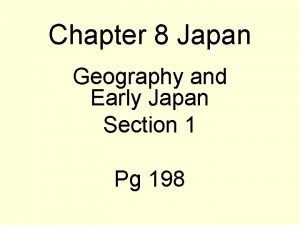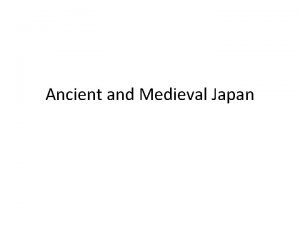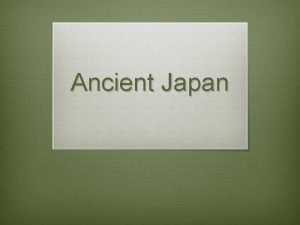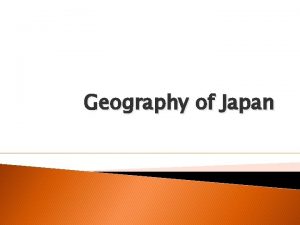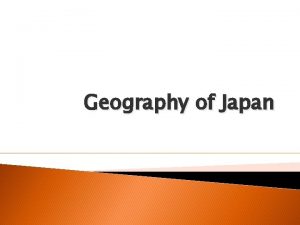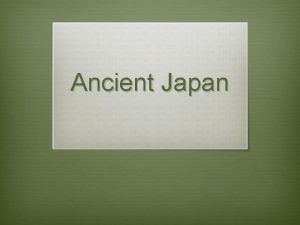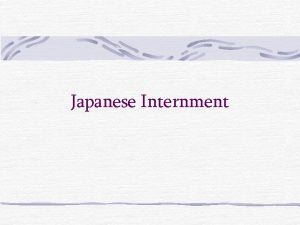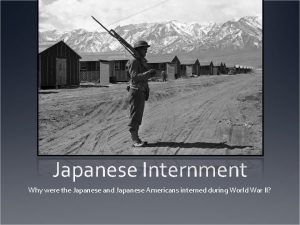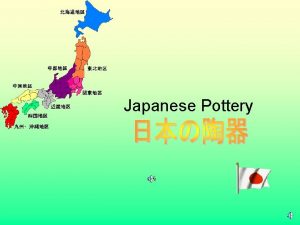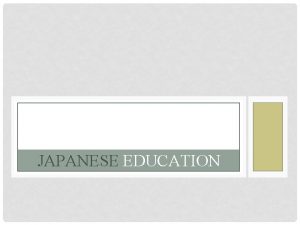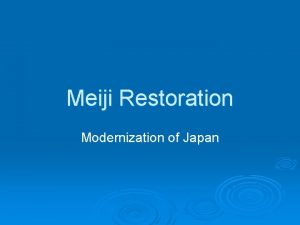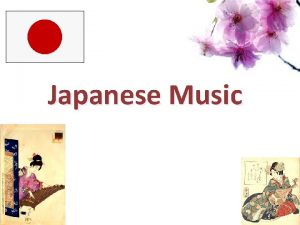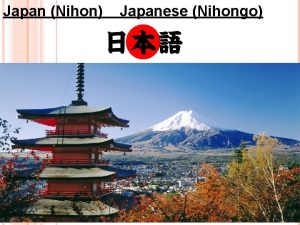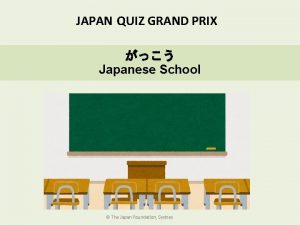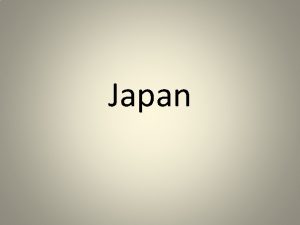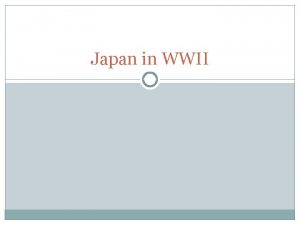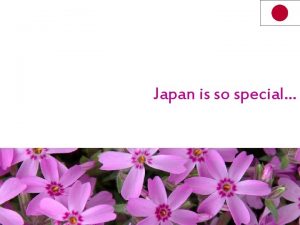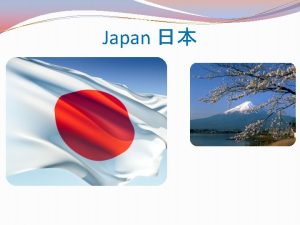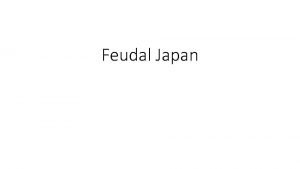LT 1 JAPANESE GEOGRAPHY Japan lies of the


























- Slides: 26

LT 1 – JAPANESE GEOGRAPHY

• Japan lies of the east coast of Asia. Over millions of years, the movement of Earth’s plates has pulled it further and further away from the mainland. • Japan is made up for four main islands and thousands of smaller ones. • From North to South the main islands are called Hokkaido, Honshu, Shikoku, and Kyushu. • Most of Japan is covered in hills and mountains. Only around 20% of the land is flat enough to build or farm on.

• Japanese farmers grew rice and raised animals on the areas of flat land near the coast. • Seafood has been a major part of the Japanese diet for thousands of years. • Many different types of fish are eaten as well as crabs, lobsters, octopus, and seaweed. • Japan’s most famous food is sushi – raw fish combined with rice, vegetables, and fruits – often in very artistic styles.

• Japan is located on the Ring of Fire – a chain of volcanoes around the Pacific Ocean. • The land is very unstable and often experiences large earthquakes. On in 1923 destroyed most of Tokyo and killed over 100, 000 people. • Some earthquakes can create huge waves called Tsunami which can wash many miles inland – destroying everything in their path. A tsunami in 2010 killed over 20, 000 people. • Japan’s volcanoes sometimes erupt covering farms and crops in a layer of ash. Tokyo is built close to Japan’s most famous volcano, Mount Fuji. • Every year Japan is hit by large tropical storms called typhoons. These can have winds with speeds of almost 200 mph. They can also cause flooding as they dump huge amounts of water on the land.

LT 2 – EARLY JAPAN

• During the last ice age, Japan was linked to Asia by land bridges • Between 40, 000 and 30, 000 years ago people began to migrate to Japan following the herds of animals they hunted. • Over the next 20, 000 years they began making and using tools which allowed them to hunt more animals and catch fish. • By around 1, 000 BC, the Japanese had learned how to grow rice which allowed them to settle down in the first small villages.

• People in early villages all belonged to the same extended families. Eventually some of these grew into clans, led by chiefs. • Chiefs organized their communities and led religious services. Some began to claim that they were descended from powerful nature spirits called Kami. • Eventually a religion called Shintoism would develop. Shintoists believed that everything in nature had a spirit. • People built temples and shrines where they could pray to, and leave offerings for, these spirits. People would also pray to the spirits of their ancestors.

• In around 1, 000 BC, the Japanese learned how to make iron from the Koreans and Chinese. Warriors used iron weapons to conquer new territories while farmers used iron tools to clear land grow more food. With more food, the population began to increase. • Between 250 and 500 AD, a powerful clan called the Yamato began to conquer its rivals. • The Yamato leaders claimed that they were descended from the most powerful of all the kami – the goddess of the sun. They then began calling themselves the emperors of all Japan. • The Yamato began to push out other peoples from their lands. The most famous of these were the Ainu – whose appearance, language, and culture was very different to other groups in Japan. Eventually, the Ainu were forced onto the northern island of Hokkaido.

LT 3 – CHINA & KOREA

• By 500 AD, the Japanese had created many trading links with China and Korea. • Japanese rulers began to see that the cultures and societies of these two countries were much more advanced and wealthier than their own. • They began sending officials to these countries to learn more about them. They also hired Chinese and Koreans to come to Japan. • One of the most important early influences were Korean shipbuilders who helped the Japanese to improve their boat designs. Fishermen could now sail further out to sea and catch more fish.

• The early Japanese had no written language of their own. • Between 400 and 600 AD, the Japanese began using the Chinese writing system which used symbols called kanji to represent objects, sounds, or ideas. • During the 700 s AD, the Japanese developed their own writing system called Hiragana which used simple symbols to represent sounds. • Eventually these two writing systems were combined. However, many wealthy or powerful people continued to write only in Chinese which became the official writing system of the government.

• One of the most important early rulers of Japan was Prince Shotoku. • During his reign he created a more powerful central government. Important positions were given to people based on their skills rather than simply because of their birth. • Shotoku welcomed Buddhist missionaries from China and Korea. He then helped to spread Buddhism by building new temples. He also built many Shinto shrines. • Eventually the two religions would merge into what became known as Shinto-Buddhism. This is the religion still followed by most people in Japan today.

LT 4 – HEIAN PERIOD

• In 794 AD, the emperor decided to move the capital city of Japan to the city of Heian (Kyoto) • He was followed by a large number of powerful nobles who created an imperial court. • Nobles at court quickly became more interested in their own fortunes and positions than in running the country. • Most devoted their lives to art and culture and knew very little about the world outside the city. They began using the phrase “dwellers amongst the clouds” to describe themselves.

• Men and women at the court competed for the attention of the emperor. • Noble clothing often had 12 layers of expensive silks decorated with gold and silver threads. • Nobles often carried expensive fans which were decorated with poetry or nature images. • A favorite past time of nobles was to take part in poetry writing parties. Nobles could write special poems called Tanka which had a set number of syllables and lines. These poems were based around ideas like love and nature. These poems would then be read out – sometimes with music accompanying them.

• Buildings at Heian were built from light materials like wood and paper. • The goal of builders was to create a natural feel so the wood was often left unpainted. • Palaces and temples were surrounded by gardens which featured trees, flowers, and ponds. • The design of the gardens was based on an ancient Chinese belief called Feng-sui. People believed that good and bad energy could be brought in or expelled based on how the gardens and buildings were arranged.

• Nobles enjoyed going to plays called Noh theater plays combined acting, music, and dance. They would last for several hours so only wealthy people could afford to go to them. • Ordinary people enjoyed entertainments like singing, music, and acrobatics. • Noble women often learned to play a harp-like instrument called a koto. • Ordinary people played bamboo flutes, drums, and a guitar-like instrument called the Shamisen.

LT 5 – DAIMYO, SAMURAI, & SHOGUNS

• By the 1100 s AD, Japan’s rulers and nobles simply ignored anything outside of the city of Heian. • At the same time, Japan’s powerful landowners (Daimyo) began fighting each other for power and land. • In the fighting, many farms were destroyed causing famines in which millions starved. Many poor people became bandits – robbing others to survive. • To defend themselves, Daimyo began hiring warriors called Samurai – paying them in land or rice. • Samurai would promise to be loyal to their Daimyo. The Daimyo promised to be loyal to the emperor but most simply did whatever they wanted.

• Between the 1150 s and 1190 s several powerful Daimyo fought for control of Japan. • By 1192 the leader of the Minamoto Clan, Yoritomo, had defeated all his rivals. • Yoritomo decided to seize power but he could not get rid of the emperor. Instead he decided to keep the emperor as a figurehead – a person who appears to rule even though real power is held by someone else. • Yoritomo took the title of Shogun, or “general”. • Shoguns would rule Japan for the next 700 years.

• Samurai enjoyed many privileges under the rule of the Shoguns. Ordinary people had to bow and avert their eyes when they passed. If a Samurai though a person had not shown them enough respect they were allowed to execute them. • Samurai were expected to behave with dignity. They were not allowed to go to theater and could not take part in any kind of business. • All Samurai followed a code called Bushido or, “the way of the warrior”. • The first duty of a Samurai was to learn how to fight to protect their Daimyo and their family. Samurai women also learned how to fight to defend their homes while their fathers or husbands were away.

• To improve their discipline, Samurai took part in rituals and activities which required great concentration and patience. • These included tea ceremonies, flower arranging, making miniature Bonsai trees, and meditation. • Honor was very important for all Samurai. If a Samurai lost honor by failing to obey an order or losing a battle he was expected to commit seppuku, or suicide. Doing this would restore his and his families honor.

LT 6 – CHALLENGES TO THE SHOGUN

• During the 1200 s AD, a people called the Mongols managed to conquer most of China and Korea. • Mongol rulers began to demand that Japan pay it tribute in the form of gold, silver, and food. However the Japanese refused. • In 1274 the Mongols invaded Japan. The Japanese were not well prepared to fight the Mongols. Samurai were used to fighting one-on-one duels while the Mongols fought with hundreds of soldiers armed with spears, bows and arrows, and gunpowder weapons. • The Japanese were close to defeat when a large typhoon began to develop – destroying or damaging many Mongol ships. The Samurai then used small boats to board the surviving ships and kill their crews.

• The Japanese were worried that the Mongols might return so they spent huge amounts of money building forts and walls on the coast. • The Mongols sent messengers to Japan to demand more tribute but the Shogun had them executed. • In the spring of 1291 the Mongols sent two huge fleets towards Japan from China and Korea. On the ships were over 150, 000 soldiers. • The Mongols tried to break through the Japanese defenses but failed. Another typhoon began to develop which sunk most of the Mongol fleet and forced the survivors to retreat. The Japanese called this storm the “Kamikaze” or “Divine Wind” and believed it had been sent by the gods to save Japan.

• After the war, many Daimyo thought the Shogun was taking too much credit for the victory. The cost of the defenses also meant that the Shogun couldn’t afford to reward them. • During the 1330 s a new emperor tried to take power back from the Shogun. During the war between them, many Daimyo took advantage of the chaos to break free of the control of both. • By the 1400 s, Japan was divided into hundreds of small states – each ruled by a different Daimyo. • Daimyo constantly tried to conquer or assassinate their rivals using hired spies called ninja. Families began to tear apart as sons tried to kill their fathers and brother fought against brother.
 Geography of japan
Geography of japan Feudal japan geography
Feudal japan geography Geography of japan
Geography of japan Japan physical geography
Japan physical geography 5 themes of geography japan
5 themes of geography japan Ap human geography political geography test
Ap human geography political geography test Frq format ap human geography
Frq format ap human geography 5 themes of geography ap human geography
5 themes of geography ap human geography Hát lên người ơi
Hát lên người ơi điện thế nghỉ
điện thế nghỉ Một số thể thơ truyền thống
Một số thể thơ truyền thống Trời xanh đây là của chúng ta thể thơ
Trời xanh đây là của chúng ta thể thơ Số nguyên tố là
Số nguyên tố là Tỉ lệ cơ thể trẻ em
Tỉ lệ cơ thể trẻ em Vẽ hình chiếu vuông góc của vật thể sau
Vẽ hình chiếu vuông góc của vật thể sau Các châu lục và đại dương trên thế giới
Các châu lục và đại dương trên thế giới Thế nào là hệ số cao nhất
Thế nào là hệ số cao nhất Hệ hô hấp
Hệ hô hấp ưu thế lai là gì
ưu thế lai là gì Tư thế ngồi viết
Tư thế ngồi viết Bàn tay mà dây bẩn
Bàn tay mà dây bẩn Hình ảnh bộ gõ cơ thể búng tay
Hình ảnh bộ gõ cơ thể búng tay đặc điểm cơ thể của người tối cổ
đặc điểm cơ thể của người tối cổ Mật thư tọa độ 5x5
Mật thư tọa độ 5x5 Tư thế ngồi viết
Tư thế ngồi viết Chó sói
Chó sói Thẻ vin
Thẻ vin
